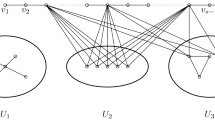Abstract
Given non-negative integers \(r, s,\) and \(t,\) an \([r,s,t]\)-coloring of a graph \(G = (V(G),E(G))\) is a mapping \(c\) from \(V(G) \cup E(G)\) to the color set \(\{1,\ldots ,k\}\) such that \(\left|c(v_i) - c(v_j)\right| \ge r\) for every two adjacent vertices \(v_i,v_j, \left|c({e_i}) - c(e_j)\right| \ge s\) for every two adjacent edges \(e_i,e_j,\) and \(\left|c(v_i) - c(e_j)\right| \ge t\) for all pairs of incident vertices and edges, respectively. The \([r,s,t]\)-chromatic number \(\chi _{r,s,t}(G)\) of \(G\) is defined to be the minimum \(k\) such that \(G\) admits an \([r,s,t]\)-coloring. In this note we examine \(\chi _{1,1,t}(K_p)\) for complete graphs \(K_p.\) We prove, among others, that \(\chi _{1,1,t}(K_p)\) is equal to \(p+t-2+\min \{p,t\}\) whenever \(t \ge \left\lfloor {\frac{p}{2}}\right\rfloor -1,\) but is strictly larger if \(p\) is even and sufficiently large with respect to \(t.\) Moreover, as \(p \rightarrow \infty \) and \(t=t(p),\) we asymptotically have \(\chi _{1,1,t}(K_p)=p+o(p)\) if and only if \(t=o(p).\)
Similar content being viewed by others
References
Dekar, L., Effantin, B., Kheddouci, H.: \([r, s, t]\)-Coloring of trees and bipartite graphs. Discrete Math. 310, 260–269 (2010)
Kemnitz, A., Lehmann, J.: \([r, s, t]\)-Colorings of stars. Congr. Numerantium 185, 65–80 (2007)
Kemnitz, A., Lehmann, J., Marangio, M.: \([1,1,2]\)-Colorings of complete graphs. Congr. Numerantium 208, 99–103 (2011)
Kemnitz, A., Marangio, M.: \([r, s, t]\)-Colorings of graphs. Discrete Math. 307, 199–207 (2007)
Kemnitz, A., Marangio, M., Mihók, P.: \([r, s, t]\)-Chromatic numbers and hereditary properties of graphs. Discrete Math. 307, 916–922 (2007)
Lehmann, J.: \([r, s, t]\)-Colourings of stars and complete graphs. Diploma thesis, TU Braunschweig (2006)
Schiermeyer, I., Villá, M.S.: \([r, s, t]\)-Colourings of paths. Opuscula Math. 27, 131–149 (2007)
Villá, M.S.: \([r, s, t]\)-Colouring of paths, cycles and stars. Doctoral thesis, TU Bergakademie Freiberg (2005)
Author information
Authors and Affiliations
Corresponding author
Additional information
This research was supported in part by the Hungarian Scientific Research Fund, OTKA Grant 81493.
Rights and permissions
About this article
Cite this article
Kemnitz, A., Marangio, M. & Tuza, Z. \([1,1,t]\)-Colorings of Complete Graphs. Graphs and Combinatorics 29, 1041–1050 (2013). https://doi.org/10.1007/s00373-012-1153-3
Received:
Revised:
Published:
Issue Date:
DOI: https://doi.org/10.1007/s00373-012-1153-3




